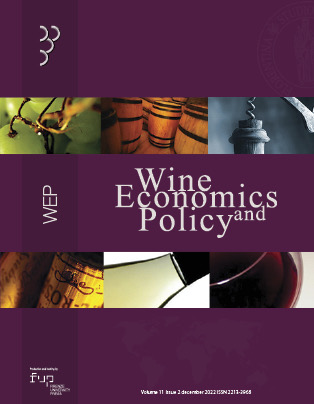Published 2022-10-18
Keywords
- ingredient and nutrition information,
- U.S. wine consumers
How to Cite
Abstract
In the United States, labelling for wine containing at least 7% alcohol by volume is regulated by the Tax and Trade Bureau, which does not require wine labels to include ingredient or nutrition labelling, except for added sulfites. With the European Union moving toward mandatory disclosure of nutrition and ingredient information for wine, one may expect the level of debate in the U.S. to increase. We conducted an online survey of consumers in the U.S. who are at least 21 years old (legal drinking age in the U.S.) and consume wine at least once every two or three months to determine their interest in wineries disclosing ingredient and nutrition information for wine. We asked about the importance of ingredient information when deciding which wine to purchase and when determining willingness to pay, and we asked about the importance of nutrition information when deciding which wine to purchase. We separately regressed three dependent variables against Wine Consumption (frequency), Price, Physical Activity, Diet, Wine Knowledge, Age, Income, and Education. Overall, respondents indicated that having ingredient and nutrition information was only somewhat important, with mean responses 3.04 on a 5-point scale (1 = Not Important, 5 = Very Important) for ingredient information when choosing a wine, 3.01 for ingredient information when determining willingness to pay, and 2.48 for nutrition information when choosing a wine. The factor with the greatest impact on interest in ingredient information was Price, with consumers who buy a higher-end wine at least monthly having a higher level of interest, followed by Diet, with consumers with a healthy diet having a higher interest in ingredient information, and Age, with older consumers having less interest in ingredient information. Price, Diet, and Age also had the greatest impact regarding interest in nutrition information, following the same direction but with Age being the most significant.
References
[2] “2020 Wine Market Council Communications Study,” Wine Market Council, September 25, 2020, https://www.google.com/url?sa=t&rct=j&q=&esrc=s&source=web&cd=&ved=2ahUKEwjr9pGAyt7zAhUBCTQIHXqrBXYQFnoECAkQAQ&url=https%3A%2F%2Fwinemarketcouncil.com%2Fwp-content%2Fuploads%2Fdlm_uploads%2F2020%2F09%2FWMC_Communications_Study_Final_9-25-2020.pdf&usg=AOvVaw0Yu88_ZVju71laSmSW0UWE (accessed 10/22/2021).
[3] “Time for US Wine to Follow the EU,” W. Blake Gray, wine-searcher.com, May 24, 2020, https://www.wine-searcher.com/m/2020/05/time-for-us-wine-to-follow-the-eu (accessed 10/23/2021).
[4] “Ingredient Labeling: A Winemaker Strikes Back,” Adam Lee, wine-searcher.com, May 28, 2020, https://www.wine-searcher.com/m/2020/05/ingredient-labeling-a-winemaker-strikes-back (accessed 10/23/2021).
[5] Bazzani C, Capitello R, Ricci EC, Scarpa R, Begalli D. Nutritional Knowledge and Health Consciousness: Do They Affect Consumer Wine Choices? Evidence from a Survey in Italy. Nutrients. 2020; 12(1):84. https://doi.org/10.3390/nu12010084.
[6] Pabst E, Corsi A, Vecchio R, Annunziata A, Loose S. Consumers’ reactions to nutrition and ingredient labelling for wine – A cross-country discrete choice experiment. Appetite. 2021; 156, 104843. https://doi.org/10.1016/j.appet.2020.104843.
[7] Annunziata A, Pomarici E, Vecchio R, Mariani A. Do Consumers Want More Nutritional and Health Information on Wine Labels? Insights from the EU and USA. Nutrients. 2016; 8(7):416. https://doi.org/10.3390/nu8070416.
[8] Annunziata A, Pomarici E, Vecchio R, Mariani A. Nutritional information and health warnings on wine labels: Exploring consumer interest and preferences. Appetite. 2016; 106: 58. https://doi.org/10.1016/j.appet.2016.02.152.
[9] Pabst E, Szolnoki G, Loose S. The effects of mandatory ingredient and nutrition labelling for wine consumers – A qualitative study. Wine Economics and Policy. 2019; 8(1):5. https://doi.org/10.14601/web-8216.
[10] Pabst E, Szolnoki G, Loose S. How will mandatory nutrition and ingredient labelling affect the wine industry? A quantitative study of producers’ perspectives. Wine Economics and Policy. 2019; 8 (2):103. https://doi.org/10.1016/j.wep.2019.05.002.
[11] Vecchio R, Annunziata A, Mariani A. Is More Better? Insights on Consumers’ Preferences for Nutritional Information on Wine Labelling. Nutrients. 2018; 10(11):1667. https://doi.org/10.3390/nu10111667.
[12] “2019 Wine Market Council U.S. Wine Consumer Segmentation Slide Handbook,” Wine Market Council, September 5, 2019, https://winemarketcouncil.com/download/914/ (accessed 10/24/2021; membership required).
[13] Grunert K, Wills J, Fernández-Celemín L. Nutrition knowledge, and use and understanding of nutrition information on food labels among consumers in the UK. Appetite. 2010; 55(2): 177. https://doi.org/10.1016/j.appet.2010.05.045.
[14] Köster E. Diversity in the determinants of food choice: A psychological perspective. Food Quality and Preference. 2009; 20(2): 70. https://doi.org/10.1016/j.foodqual.2007.11.002.

